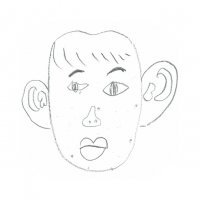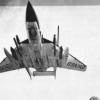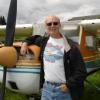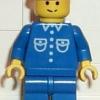

Brian J
Members-
Posts
258 -
Joined
-
Last visited
About Brian J
- Birthday 27/05/1944
Profile Information
-
Gender
Male
-
Location
Canada
Recent Profile Visitors
1,954 profile views
Brian J's Achievements

Established Member (3/9)
46
Reputation
-

Wing insignia on F-4s of VF-161 on last Midway cruise (1972-73)
Brian J replied to Brian J's topic in Aircraft Cold War
Thanks to both gentlemen for taking the time to verify my findings on the subject. I'll add clarification/detail for other members who may be interested in the subject. Since my initial post I did more checking. On page 150 of Rene J. Francillon's Tonkin Gulf Yacht Club the last war cruise of the Midway was from April 1972 to March 1973. On 23 May of 1972 F-4B 153020 NF 100 (the famous VF-161 CAG aircraft '100') crewed by R E McKeown and J C Ensch is credited with downing two MiG-17s. Several inflight photos show this aircraft with the larger wing insignia. The Kovaleski/Wise kill was on 12 January on the same cruise. Using the two above references and the two photos I found I am now confident that the larger insignia is appropriate. Another member is often quoted as warning to never use artwork as a reference unless it can be verified with photos. Those two Osprey covers I mentioned earlier are examples of that wisdom! Brian James -
While researching the markings of the last Phantom MiG kill in the Viet Nam War I came across conflicting artwork that all photos I have on the subject can't clarify. The subject in question is F-4B 153045/NF 102 crewed by Lt Victor T Kovaleski and Lt (jg) James A. Wise of VF-161. I have the 1/48 Furball sheet 48-011 which shows the wing star and bar in the larger format used until very late in the war. The cover artwork of the Osprey publication Combat Aircraft 125 US Navy F-4 Phantom II Units of the Vietnam War 1969-73 illustrates the subject aircraft with the smaller late war insignia only found on the outboard wing folding area. Can anyone help clarifying when the change was made? I believe it was late '72 to early/mid '73. The MiG kill in question was 12 January 1973. I have several photos of the subject in question but they are taken at ground level and don't show wing surfaces. On the subject of wing insignia size and Osprey colour artwork, the Combat Aircraft 30 Us Navy F-4 Phantom II MiG Killers 1972-73 cover shows the well known VF-111 F-4B 153019/NL 201 with the smaller wing insignia. The MiG kill for that aircraft was 6 March 1972 so the smaller wing insignia is incorrect. Photo verification and any other help would be appreciated.
-
Thanks for the fast response and interesting website. I found it interesting that the engine firewalls appear to be the colour of Spitfire cockpit interiors.
-
Most colour photos of wing interior colours e.g. upper and lower flap areas, engine firewall interior as well as wheel well and interior landing gear doors are taken from restored warbirds. They vary from interior green to black or a shade of zinc chromate. Was there a specific colour used for wartime aircraft or could it vary? War time photos are hard to find.
-
I noticed recently that a company called Mikro-Mir has issued a 1/48 kit of the D. H. Venom. I have the old Classic Airframes version in my stash and was wondering if anyone has made a comparsion between the two kits. I believe the Classic Airframes kit lacks an accurate canopy and intake trunking (?). Is the Mikro-Mir kit a more accurate/detailed version?
-

Aluminium painted 60 Squadron Spitfire FR. 18
Brian J replied to Brian J's topic in Aircraft Cold War
Many thanks for your helpful response, David. The inflight photo shows two Spitfire Mk.XIVs of 2 Sqn. I referred back to my Cold War Shield reference and found a small photo of another "Spitfire FR.14 NG783 0I-H of 2 Sqn in Aluminium finish, with scarlet band around spinner denoting 'A' Flt." on page 35. A larger image of the same photo can be found on page 42 of Royal Air Force Germany Since 1945 by Bill Taylor. Both photos bring up another question. The inflight photo of both aircraft from your reference show the starboard side as C-OI and 0I-A while the photo I have shows the port markings as 0I-H. There seems to be no uniformity in the placement of the unit markings. So do we have to guess as to the unit markings on the other side of all three aircraft? Brian -
I was undecided if I should pick up the recently released 1/48 Airfix FR.18 Spitfire as the kit markings are somewhat similar to the Mk XIV I recently completed. My interest was piqued this morning when reading Cold War Shield , Volume 1, by Roger Lindsay. On page 37 there is a black and white photo of the port nose, captioned, "Close up of the black/yellow stripes around the nose of a silver Spitfire FR.18 of 60 Sqn." On page 421 of the rear colour section is a profile labelled "Spitfire FR.18, SM947/A. 60 Squadron, Kuala Lumpur, Malaya, 1950" Are any members aware of other information e.g. photos, drawings, verbal reference to aluminium markings for 60 Squadron Spitfire FR. 18s? What might that colour profile be based on? It would be nice to add a FR.18 to my collection in that kind of colour scheme...or for that matter any other unit with aluminium schemes.
-

Converting 1/48 F-86F to F-86E wing/fuselage
Brian J replied to Brian J's topic in Aircraft Cold War
Many thanks for that most recent response. As I recall (hey, so I've got a short memory) I also attempted using the Revell F-86D wings. The wheel wells differ on the two aircraft. Did you just cut the wings off the 'D' version at the wing root and attach to the 'F' fuselage? Also, as I recall, when the Revell F-86D was first issued there was a lot of discussion as to the accuracy of the angle of the leading edge of the wing when compared to other versions of the Sabre. Did you give consideration to that issue? Thank goodness I can fall back on my other hobby...collecting doll house furniture! -

Converting 1/48 F-86F to F-86E wing/fuselage
Brian J replied to Brian J's topic in Aircraft Cold War
I'm not sure if the two members who responded to my inquiry have attempted to convert the F-86 kit(s) in question. I have numerous reference photos showing the leading edge wing root of a F-86E, one example can be found on page 51 of MIG ALLEY by Larry Davis (Squadron/Signal Publications). While a removeable tri-angular cap was used on the 6-3 wing conversion so the gun bay door could be opened, the gun bay door was also modified. The above mentioned photo suggests that the panel behind the gun bay door where the leading edge wing root on the narrow wing Sabre had to have also been modified. It seems to me there was more to modifying any F-86F plastic kit to an E model than just adding the 6-3 wing leading edge and sanding the gun bay door. The conversion kits in question leave much to be desired in my opinion. I'd enjoy hearing from members who may have completed a successful conversion and can share their experience. As numerous lovers of the Sabre have commented over the decades, we are in need of an accurate F-86E, or an A for that matter in any scale! -
I am pulling a couple of Hasegawa 1/48 F-86Fs off of the shelf of doom that I started a while back converting them to E's using the old Cutting Edge conversion set as well as a Scobie-Do Productions conversion set. With quite a bit of work I think they'll work (?). I have filed the leading edge root area on the gun bay door. In the process it appears there will be major issues making the wing roots fit when comparing this area found in photos. Most references suggest that there were minimal conversions when converting to the 6-3 wing leading edge e.g. changes to the gun bay door etc. Are any members aware of any other modifications done on the lower fuselage in that area? Close up photos of this area suggest there had to be other modifications as well. Opinions and insight would be appreciated. G. Brian James
-
I have renewed my interest in the history and markings of VF-17 'Jolly Rogers' and while going through my research material on the subject realized that I failed to purchase Vol 4 i.e. Part Two of the excellent AJ. Press volume on that subject. I realize it was first published a long while back, but is anyone aware if any copies are available for purchase? I have relearned so many things on the subject that I've forgotten! The years are taking their toll and it ain't pretty. Brian
-
I have given thought to the various responses to my initial question on this topic. I tried to e-mail ARMA for clarification on their part but failed after trying to contact them. After reading the various posts that members were kind enough to include I can't help but agree with the opinion of Troy Smith that, "...never trust a profile without a photo." One of the reasons is that the ARMA profile suggests a yellow or red half spinner while other profiles suggests it was all black or all red. The size of the fuselage roundel also comes into question. I have the Xtradecal sheet X72-113 and two b&w photos of BD867/QO-Y from 3 Sqdn and may end up doing a model with markings I can verify using photographs. I seems like a modeler can have too many references that often contradict each other and can't make up their mind. Being wishy-washy is terrible burden! Brian
-
I recently picked up the new Hurricane Mk. II B/C from ARMA HOBBY and am very impressed with the tooling compared to earlier 1/72 Hurricane kits from other companies. My posting has to do with the markings of BE581/JX-E flown by F/L Karel Kuttelwasher. Back in February of 2015 I started a long thread on the markings of this aircraft and received numerous comments which included comments by Nick Millman. It appears to me that the markings of this aircraft that are included in the ARMA kit are based on Nicks comments about the 1942 artwork of J H Striebel, a small coloured imaage of which was included in his comments. In other words, what do you think of the ARMA markings/decals? Would any interested members concur with my conclusion or are the ARMA markings new findings? There have been so many interpretations of these markings over the decades it is difficult to draw any positive conclusions...ain't that the truth about so many WWII markings/paint schemes! Brian James
-
Many thanks to the members who took the time to clarify the topic. I will proceed with confidence...I'm pretty sure! I came across a decal company a while back and was very impressed with their product line in all three major scales. Most subjects deal with the South Pacific Theatre. I include the following example, 48023/P-40K Warhawk, 48042/Kittyhawk Mk IV and 48048/P-40N. I'd be interested to hear comments if anyone checks out the site. They can be reached at www.dkdecals.cz
-
Thanks for that additional comment. After I forwarded my last comment I referred to those Three Guys Replicas decal instructions you referred to. The two modeling subjects in question apparently were early -5 versions which would suggest, according to Three Guys Replicas, they would have had the green disruptive pattern. The art work illustrates 'yellow 51' with a white bar and red surround to the cocarde while 'white 20' has the white bar but lacks the red surround. This clarifies somewhat the time period. While there are b&w photos that show both sides of the nose art of 'white 20' Keystone Kathlene I would love to know what the other markings of both aircraft are based on. Remember when we were kids and all we had was the box art for reference and we had to use left over kitchen paint to complete our models? And they were beauties...as I recall!







